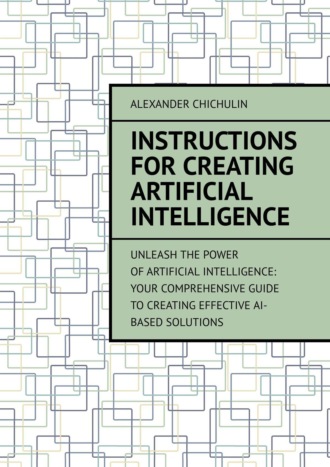
Полная версия
Instructions for creating artificial intelligence

Instructions for creating artificial intelligence
Alexander Chichulin
© Alexander Chichulin, 2023
ISBN 978-5-0060-0357-6
Created with Ridero smart publishing system
Step 1: Define the problem
Creating artificial intelligence is a complex and multidisciplinary field that requires expertise in computer science, mathematics, statistics, and other related fields. Here are some high-level steps you can follow to create artificial intelligence
– Start by defining the problem you want the artificial intelligence system to solve. This can be anything from recognizing objects in an image to predicting customer behavior
Defining the problem is the first and most critical step in creating an artificial intelligence system. It’s important to have a clear understanding of the problem you want to solve and the end goal you want to achieve. Here are some tips for defining the problem:
1. Start with a high-level goal: Identify the overarching goal that the AI system should achieve. For example, if you’re creating a chatbot, the high-level goal might be to provide customer support 24/7.
2. Break down the goal into subproblems: Once you have identified the high-level goal, break it down into smaller subproblems. This will help you to identify the specific tasks that the AI system should perform. For example, for the chatbot, the subproblems might include understanding user queries, providing relevant responses, and handling multiple queries simultaneously.
3. Determine the input and output: Clearly define the input and output for the AI system. This will help you to understand the type of data you need to collect and how the AI system will generate output. For example, for an image recognition system, the input would be an image, and the output would be the object or objects recognized in the image.
4. Identify the limitations: It’s important to identify the limitations of the AI system upfront. This includes limitations in terms of data availability, computing resources, and the accuracy of the system.
5. Refine the problem: Once you have defined the problem, refine it further based on feedback from stakeholders and other experts in the field. This will help you to ensure that the problem is well-defined and achievable.
By following these steps, you can define a clear and well-structured problem statement that will guide the development of your artificial intelligence system.
Step 2: Gather data
– The success of an AI system depends heavily on the quality and quantity of data used to train it. Collect as much relevant data as possible for your problem
Data is the foundation of any artificial intelligence system, and collecting high-quality and relevant data is critical for the success of the system. Here are some steps you can follow to collect and prepare data for training your AI system:
1. Identify the data sources: Start by identifying the sources of data that you can use to train your AI system. This might include publicly available datasets, proprietary data, or data generated by sensors or other devices.
2. Define the data parameters: Define the data parameters that are relevant to your problem. This might include data type (e.g., text, images, audio), data format (e.g., CSV, JSON, binary), and data quality (e.g., resolution, noise).
3. Collect and preprocess the data: Collect as much data as possible, but make sure that the data is relevant and of high quality. Preprocess the data by cleaning, normalizing, and transforming it so that it can be used for training.
4. Label the data: If your AI system is a supervised learning system, you will need to label the data. Labeling involves assigning a category or tag to each data point, so that the AI system can learn to recognize patterns and make predictions.
5. Augment the data: In some cases, you may not have enough data to train your AI system. In this case, you can use data augmentation techniques to generate more data from existing data. This might include techniques like flipping, rotating, or scaling images.
6. Split the data: Split the data into training, validation, and test sets. The training set is used to train the AI system, the validation set is used to tune the hyperparameters of the model, and the test set is used to evaluate the performance of the model.
By following these steps, you can collect and prepare high-quality data that will help you to train your AI system effectively. It’s important to note that data collection and preparation can be a time-consuming and resource-intensive process, but it’s a critical step in the development of an effective AI system.
Конец ознакомительного фрагмента.
Текст предоставлен ООО «ЛитРес».
Прочитайте эту книгу целиком, купив полную легальную версию на ЛитРес.
Безопасно оплатить книгу можно банковской картой Visa, MasterCard, Maestro, со счета мобильного телефона, с платежного терминала, в салоне МТС или Связной, через PayPal, WebMoney, Яндекс.Деньги, QIWI Кошелек, бонусными картами или другим удобным Вам способом.











